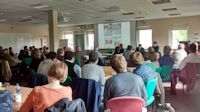Analysing the General Election 2015
Posted on 21 May 2015

On the 13th of May, the Department of Politics organised a roundtable on the General Elections, open to the wider public. The speakers analysed the main features of the campaign, with a focus on the TV debates, the overall media coverage, the issues that structured the public debate and the main events that punctuated the period before Election Day. The event was attended by over 70 members of the public, students and staff of the university.
Neil Carter ranged widely across the campaign, media coverage, problems with opinion polling, the performance of the Liberal Democrats, Greens and UKIP, and the electoral implications of the upcoming boundary review. He argued that the focus of media coverage on the party leaders - with the sharply contrasting positive coverage of David Cameron and negative reporting of Ed Miliband - and the predicted hung parliament, allowed the Conservatives to press home the 'Vote Labour, Get the SNP' message to decisive effect.
Jim Buller discussed the relationship between the economy and voting behaviour in the election. He argued that the Conservatives spent a lot of the campaign stressing their ‘competent’ handling of the economy over the last five years and this argument appears to have had a significant impact on the final result. However, other factors cannot be discounted, not least Conservative warnings of the ‘dangers’ of a Labour-SNP alliance in government. There is some evidence that this assertion had an impact on UKIP voters in some marginal seats, leading them to switch to the Tories in the final stages of the campaign.
Nicole Lindstrom focused on the post-election promise of an in/out EU referendum. She argued that the number one issue in UK renegotiations was likely to focus on restricting EU migrant access to benefits. The UK may win some minor and largely symbolic concessions here, which Cameron can sell at home as a victory. But securing a ‘yes’ vote will ultimately depend on convincing enough potential ‘no’ voters that the risk of exiting the EU is too high, and luck that events, such as a Greek exit, won’t put UK popular opinion on the EU out of Cameron’s control.
Ignacio Jurado analysed the extent to which this has been an atypical British election. First, the electoral result is very consistent with patterns all over advanced democracies by which economic growth in the year previous to the election is crucial for explaining the incumbent's electoral fate. Secondly, the increase in the number of parties is in line with a trend towards more party pluralism all over Europe. In addition, this trend normally involves the emergence of strong non-state wide parties, such as the SNP, and radical right parties (such as UKIP). Finally, Ignacio Jurado analysed what went wrong with the Labour party. Despite looking in good shape before the election, three (non-exclusive) possible explanations were proposed: the Labour party did not perform well in marginal constituencies, it failed to persuade undecided voters, and the threat of a decisive SNP in Westminster could have demobilised some potential English voters.
Martin Smith looked at the constitutional implications of the election and in particular at the fact that issues of democratic legitimacy were raised. The Conservatives claim a mandate to implement their manifesto when they only received 37 per cent of the vote. The problem is that a pre-democratic electoral system worked when there were two main parties with national representation, but the level of disproportionality is too high in a multi-party and regional system. No party now has national representation. As a consequence, whilst parties may have a short-term interest in the first past the post system, the need to overcome opposition to the Westminster parties, maintaining legitimacy and the Union means that all parties should consider electoral reform.
The researchers’ interventions were followed by an extensive and lively Q and A with the audience.
